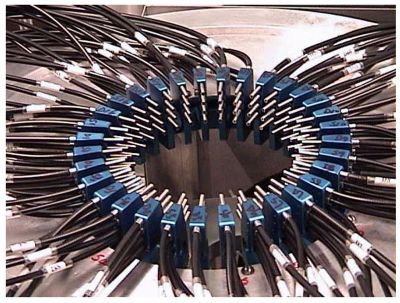Towards quantum teleportation

Diffuse Optical Tomography
By Hajihashemi MR, Grobmyer SR, Al-Quran SZ, Jiang H (2012) [CC BY 2.5 (http://creativecommons.org/licenses/by/2.5)], via Wikimedia Commons
By enhancing quantum control of mechanical devices, EU-funded scientists opened the door for linking quantum physics laws to the macroscopic everyday world.
Controlling microscopic physical systems has already been demonstrated
successfully in numerous experiments, in particular in the field of
quantum optics. Current research interest focuses on achieving
quantum-mechanical control at the macroscopic scale as well.
Promising systems for this purpose are mechanical oscillators. The
EU-funded project 'Optomechanical entanglement and teleportation'
(OMENT) was established to demonstrate quantum control of a
micrometre-sized mechanical oscillator and use it for a crucial quantum
information application: teleportation.
OMENT sought to prepare low-entropy mechanical states such as the
ground state of an optomechanical oscillator. Based on this, scientists
would create and verify entangled optomechanical states. Such states
only appear in quantum mechanics and are the resource in numerous
quantum information applications. The created optomechanical
entanglement would be used to teleport information.
Novel optomechanical protocols included suggestions on how to
implement optomechanical entanglement, teleportation and ultrafast
cooling schemes in the pulsed optical regime.
A decisive step in OMENT was to use mechanical oscillators with high
Q factors — lower rates of energy losses — as high as 10^7 at low
temperatures. Scientists investigated a novel material system based on
indium gallium phosphide (InGaP) for membrane mechanical resonators.
This allowed easy and monolithic integration of stacked membranes that
promise a high single-photon coupling strength.
Major effort was devoted to achieve two stable cavity-optomechanics
systems at low temperatures in a dilution refrigerator and a helium flow
cryostat.
Quantum-controlled mechanical oscillators extend the physical
regimes of information processing where quantum effects are significant
to macroscopic scales. Furthermore, they also allow designing
ultra-sensitive quantum-limited measurement devices.
Project advances significantly contributed to realising a set of
experimental parameters that should eventually allow observing
optomechanical quantum entanglement between a laser field and a
micromechanical oscillator. All project findings were published in
peer-reviewed journals.
published: 2015-03-20

